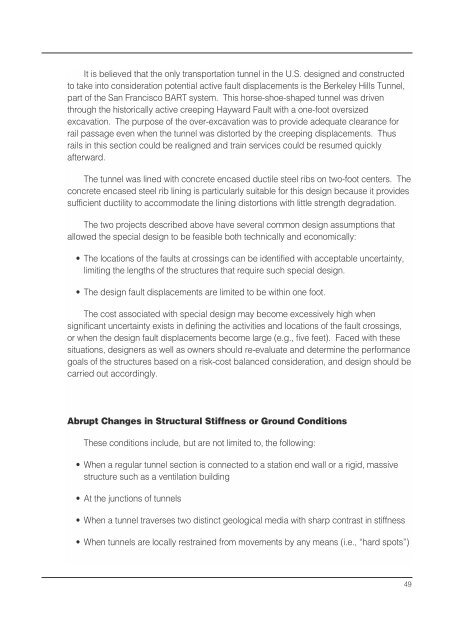Seismic Design of Tunnels - Parsons Brinckerhoff
Seismic Design of Tunnels - Parsons Brinckerhoff
Seismic Design of Tunnels - Parsons Brinckerhoff
You also want an ePaper? Increase the reach of your titles
YUMPU automatically turns print PDFs into web optimized ePapers that Google loves.
It is believed that the only transportation tunnel in the U.S. designed and constructed<br />
to take into consideration potential active fault displacements is the Berkeley Hills Tunnel,<br />
part <strong>of</strong> the San Francisco BART system. This horse-shoe-shaped tunnel was driven<br />
through the historically active creeping Hayward Fault with a one-foot oversized<br />
excavation. The purpose <strong>of</strong> the over-excavation was to provide adequate clearance for<br />
rail passage even when the tunnel was distorted by the creeping displacements. Thus<br />
rails in this section could be realigned and train services could be resumed quickly<br />
afterward.<br />
The tunnel was lined with concrete encased ductile steel ribs on two-foot centers. The<br />
concrete encased steel rib lining is particularly suitable for this design because it provides<br />
sufficient ductility to accommodate the lining distortions with little strength degradation.<br />
The two projects described above have several common design assumptions that<br />
allowed the special design to be feasible both technically and economically:<br />
• The locations <strong>of</strong> the faults at crossings can be identified with acceptable uncertainty,<br />
limiting the lengths <strong>of</strong> the structures that require such special design.<br />
• The design fault displacements are limited to be within one foot.<br />
The cost associated with special design may become excessively high when<br />
significant uncertainty exists in defining the activities and locations <strong>of</strong> the fault crossings,<br />
or when the design fault displacements become large (e.g., five feet). Faced with these<br />
situations, designers as well as owners should re-evaluate and determine the performance<br />
goals <strong>of</strong> the structures based on a risk-cost balanced consideration, and design should be<br />
carried out accordingly.<br />
Abrupt Changes in Structural Stiffness or Ground Conditions<br />
These conditions include, but are not limited to, the following:<br />
• When a regular tunnel section is connected to a station end wall or a rigid, massive<br />
structure such as a ventilation building<br />
• At the junctions <strong>of</strong> tunnels<br />
• When a tunnel traverses two distinct geological media with sharp contrast in stiffness<br />
• When tunnels are locally restrained from movements by any means (i.e., “hard spots”)<br />
49
















